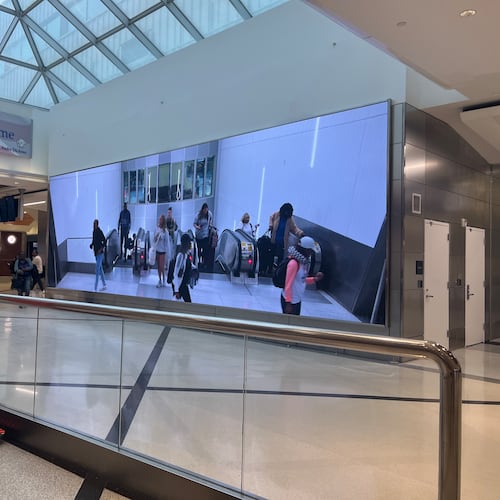Delta Air Lines plans to soon begin using facial recognition in the domestic terminal at Hartsfield-Jackson International Airport, allowing passengers who qualify to go through security and board their flights without showing identification or boarding passes.
Delta SkyMiles frequent fliers who are members of TSA’s trusted traveler program PreCheck and have passports will be able to opt in to use facial recognition to get through the airport when flying Delta. Before, only the carrier’s international passengers had that choice.
Hartsfield-Jackson and other airports have explored ways to move travelers through the terminals with “touchless” technology to reduce contact and bottlenecks. Delta says its aim is to turn security and check-in into “seamless experiences.”
Delta, which has said it is investing in ”the travel experience of tomorrow,” said this move brings it “one step closer to achieving our vision of creating a more personalized and fully connected travel journey,” according to a written statement from Byron Merritt, the company’s vice president of brand experience design.
But the expansion of the biometric technology has raised privacy concerns, even though Delta says those who do not want facial scans can decline it at check-in and go through the regular process.
Atlanta-based Delta first launched the use of facial recognition for domestic flights at its Detroit hub earlier this year. Airline executives plan to roll it out to other hubs next year.
In the next few weeks, Delta will add facial recognition equipment to Hartsfield-Jackson’s south security checkpoint, which is near Delta’s check-in area and dedicated to PreCheck members. Facial recognition will expand to some of Delta’s domestic bag drop and boarding gates later this year.
While Delta describes its partnering with TSA PreCheck to use the technology as an “industry first,” facial recognition has been tested or launched in various forms by other airlines and at other airports across the country.
Delta has employed facial recognition in the international terminal at Hartsfield-Jackson since 2018.
It‘s easier to use facial recognition on passengers traveling outside of the country because airlines can rely on U.S. Customs and Border Protection’s federal passport database for facial image matching.
For domestic flights, however, passengers may not have passports, just driver licenses as ID. The photos used on those are in different state databases instead of one system.
Passengers interested in using Delta’s facial recognition system to get through airports faster for domestic travel must participate in TSA’s PreCheck program. PreCheck costs $85 to register for five years and $70 to renew for another five years
Some airlines, including Spirit, have tried using facial recognition on domestic passengers on a more limited basis. Spirit launched use of biometric photo matching at a couple of airports with the aim of getting Transportation Security Administration approval for broader use.
Passengers who pay for a membership to Clear are already able to use fingerprints or an iris scan to get through security without showing ID. Clear membership costs $179 a year, with lower rates for Delta frequent fliers.
Delta facial recognition at Hartsfield-Jackson’s domestic terminal
Here’s how it will work:
- Passengers must store passport information and TSA PreCheck or Global Entry Known Traveler Number in their SkyMiles profile in the Fly Delta app.
- They then opt into facial recognition use through the Fly Delta app.
- At the airport, passengers must look into the camera at bag drop, the security checkpoint and the boarding gate.
Source: Delta
About the Author
The Latest
Featured



